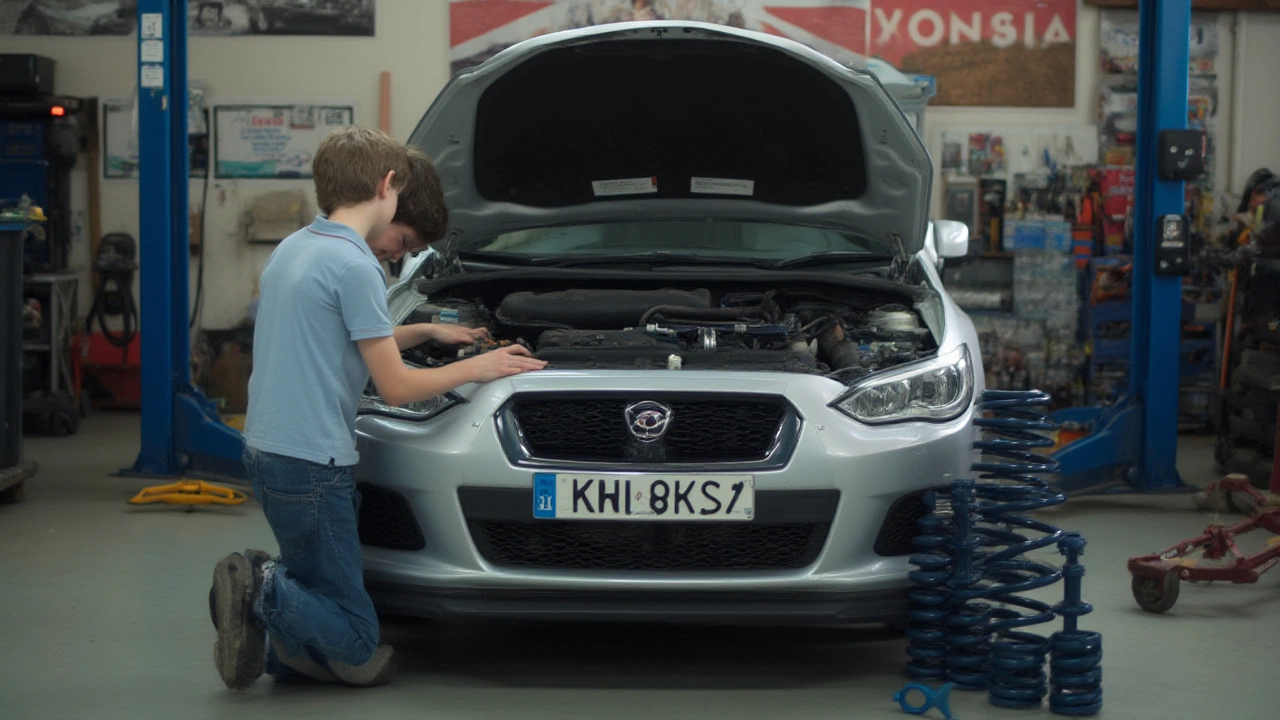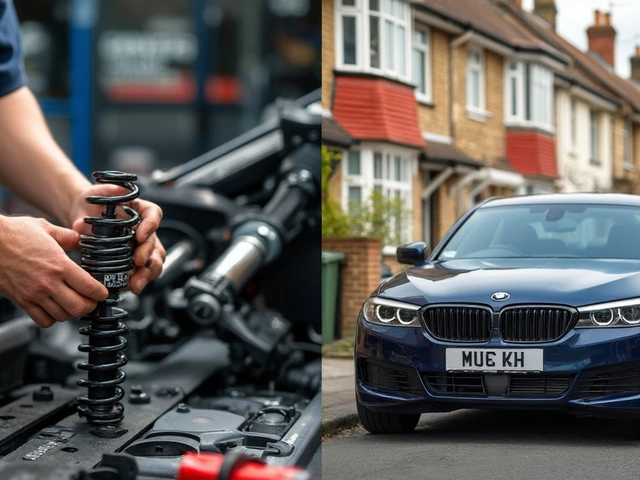Picture this: you’re stuck behind a guy on Nepean Highway, his car scraping on every tiny bump, his teeth rattling—and you can’t help but think, "Did he pick the wrong suspension mod for street driving?" Suspension upgrades promise tighter handling and a killer look, but not every option fits daily life. The real debate? Lowering springs or coilovers for daily driving. Most people just want a better stance and less fidgety cornering—without feeling every pothole in town.
How Lowering Springs and Coilovers Actually Work
If you’re new to the world of suspension tweaks, let’s clear things up. Lowering springs swap in for your car’s stock springs. They’re wound tighter, usually a bit shorter, and lower the ride height, dropping the center of gravity for less body roll. You get one fixed drop—maybe 20-40mm down—and keep your original shocks. Sounds simple, right? But the stock shocks might not love the extra tension, wearing out faster. Your first week feels planted, but several months in, those shocks can get tired, especially on trash roads.
Coilovers, on the other hand, are a package deal: springs and shocks fused together with an adjustable collar. Instead of one set-it-and-forget-it ride height, you can tweak your car to sit higher or lower, often with additional adjustments for damping (think sport mode for your shocks). This means stiffer or softer rides on demand. But with all that flexibility comes a heftier price tag and more time spent getting it dialled for city driving.
Younger drivers love the look of slammed cars with coilovers, but often regret them when they learn how punishing a bad setup can be in unpredictable traffic or on suburban streets. A German auto magazine did a blind ride quality test between professionally installed lowering springs and entry-level coilovers on VWs—a surprising 70% of drivers preferred the springs for daily commutes, citing a more natural feel.
Comparing Ride Comfort for Everyday Use
Daily drivers want a balance, not a kidney punch. Lowering springs, when paired with quality shocks, offer mild lowering (rarely more than 30mm), so you get that sportier look without feeling every groove in the tarmac. Most modern springs are progressive, meaning they’re soft over little bumps but stiffen the more you compress them. So you don’t crash over driveway lips or speed humps. If you stick to reputable brands like Eibach, H&R, or King Springs (made right here in Australia), the complaints about harshness are rare—unless you bottom out with worn shocks or go overboard with super-low options meant for track days.
Coilovers? There’s a trade-off. The adjustability sounds fantastic… until it isn’t. Entry-level kits often favor lower cost and stiffer fixed dampers. You can fine-tune height, but if you mess up the preload or the damping clicks, you risk either bouncing or scraping over every surface. On top kits costing north of $2000, like KW or Bilstein, do a much better job at soaking up daily imperfections, but installation and setup aren’t exactly set-and-forget.
A study by the UK’s Auto Express in 2023 tested a Toyota Corolla’s handling and ride with both setups. Lowering springs dropped lap times only marginally, but coilovers offered real gains—only when set up soft and properly tuned. The daily comfort winner? Quality springs, by a mile, unless professionally installed premium coilovers were involved. For most commuters, springs hit the sweet spot between sporty and sensible.

Handling and Safety: Which Actually Improves Your Car?
Everyone wants sharper cornering, less roll, and a planted feeling—especially when taking a tight roundabout a bit faster than you should. Both lowering springs and coilovers lower the car’s center of gravity, translating to less pitch and body movement. But here’s where things split.
Lowering springs matched to your factory shocks typically improve handling, at least up to moderate speeds. Steering feels more direct, and you get a tiny bump in road feedback. But push hard—like during an emergency swerve or unexpected obstacle—and stock shocks might not keep up if they’re overwhelmed. For regular city and occasional country drives, this isn’t a dealbreaker. Safety features like traction and stability control still back you up.
Coilovers come alive for spirited driving or amateur track days. When set up right, you can chase apexes and late braking with confidence, because you control both ride height and shock response. But with all this adjustability, things can go wrong—set them too stiff or too low, and grip can actually suffer. Not every coilover system is engineered for safety on pothole-ridden suburban streets. And if you don’t align the car properly afterward, you might chew up tires faster than BBQ at a footy game.
Check out this comparison table:
| Feature | Lowering Springs | Coilovers |
|---|---|---|
| Ride Comfort | Good (if shocks are fresh) | Varies widely (requires tuning) |
| Adjustability | None | High (ride height, often damping) |
| Installation Cost | $400–$800 | $1,000–$4,000 |
| Daily Usability | Excellent | Risky if not dialled in |
| Recommended For | Street, daily driving | Track, spirited street, custom height |
Handled right, both can improve safety—handled wrong, both can make things worse. Springs are simpler and harder to mess up.
Practical Tips and Unexpected Pitfalls
Before you drop cash on fancy hardware, ask yourself: What kind of driving do you do? If your car is mostly a commuter, reliability and comfort matter more than shaving a second off your cornering speeds. Install quality lowering springs with matched shocks, and you’re getting 80% of the gains for 20% of the price and headache.
For coilovers, don’t go for the cheapest ones off eBay—you’ll pay twice in the end, usually with aching joints and worn axles. Stick with brands like Tein, Bilstein, BC Racing, or Australian-made MCA Suspension. Budget at least $1500 for a quality kit and professional installation. And don’t forget: after any suspension change, you need a wheel alignment, or you’ll eat through tires fast.
Common mistake? People set their cars way too low with coilovers, forgetting Australian driveways and speed bumps are not designed for stanced cars. This ends with scraped undertrays and busted oil pans. If you lower the car more than 40mm, you also risk failing a roadworthy inspection or getting hassled by cops on a bad day.
Hidden tip: Always replace worn out rubber bushings and bump stops during installation. Squeaks and clunks are usually from old bushings, not bad springs or shocks. And don’t be afraid to ride along in a mate’s car who already has a similar setup—real world experience beats reading forums every time.

Choosing the Right Setup for Your Daily Drive
Look, if you want a simple upgrade, a sportier look, and don’t enjoy fussing with tools every month, lowering springs win for daily driving, hands down. They’re reliable, predictable, don’t murder your back, and you’ll get years of use from a brand-name set. Lowering springs deliver most of the handling perks while keeping things daily-usable, and you won’t be wincing over every pothole. If you do want maximum versatility, are OK with a higher spend, and love tweaking settings—high-quality coilovers from a respected maker might justify the cash.
Still can’t decide? Here’s a quick cheat sheet:
- Mostly city traffic, school runs, and work commutes: go with lowering springs.
- Plan to change wheels often or adjust ride height for show-and-shine: coilovers win.
- On a strict budget or new to mods: lowering springs are low-risk, high-reward.
- Live for carving corners and track days: properly tuned and installed coilovers pay off.
If in doubt, chase experiences from real owners in your area. Melbourne’s car scene is packed with folks willing to show off their rides—don’t be shy about asking for a test ride. Making an informed choice means you’ll drive happier every day, with zero regrets and heaps more confidence on Australia’s unpredictable roads.




